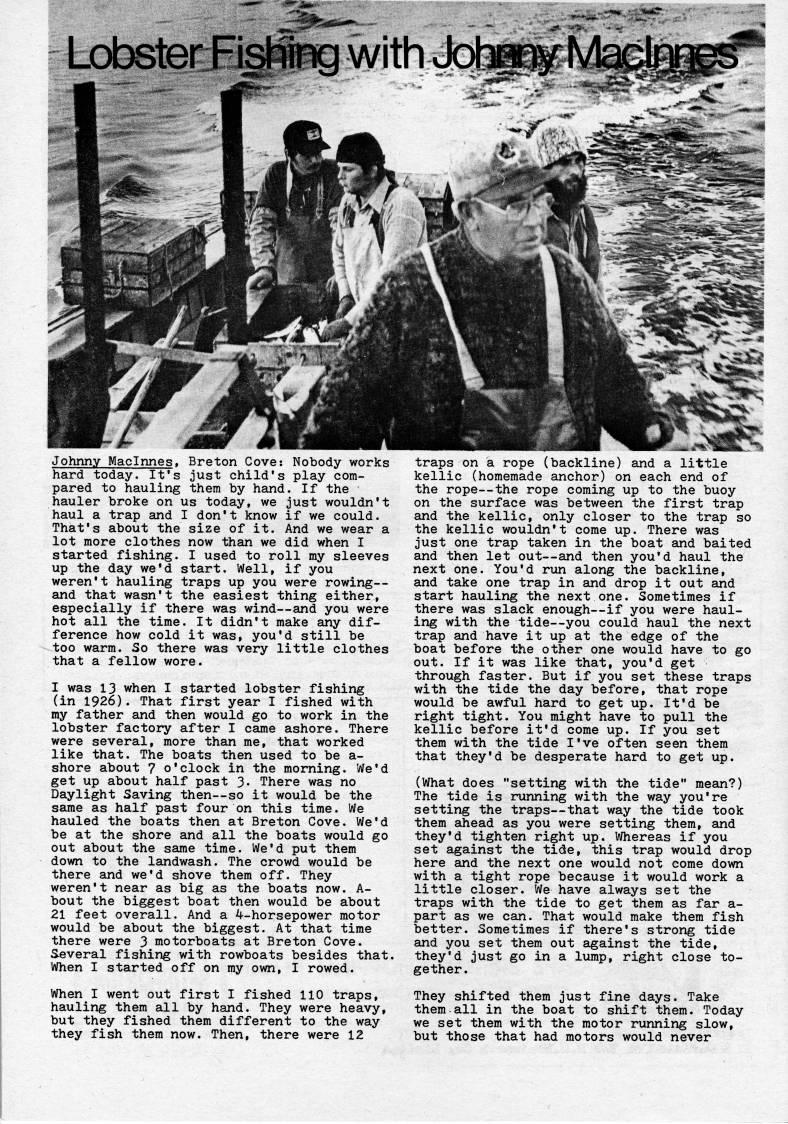Page 40 - Lobster Fishing with Johnny MacInnes
Published by Ronald Caplan on 1979/8/1 (683 reads)Lobster Fi'tag with Jotn' Johnny Maclnnes, Breton Cove; Nobody works hard today. It's just child's play com? pared to hauling them by hand. If the hauler broke on us today, we just wouldn't haul a trap and I don't know if we could. That's about the size of it. And we wear a lot more clothes now than we did when I started fishing. I used to roll my sleeves up the day we'd start. Well, if you weren't hauling traps up you were rowing • and that wasn't the easiest thing either, especially if there was wind • and you were hot all the time. It didn't make any dif? ference how cold it was, you'd still be too warm. So there was very little clothes that a fellow wore. I was 13 when I started lobster fishing (in 1926). That first year I fished with my father and then would go to work in the lobster factory after I came ashore. There were several, more than me, that worked like that. The boats then used to be a- shore about 7 o'clock in the morning. We'd get up about half past 3- There was no Daylight Saving then • so it would be the same as half past four on this time. We hauled the boats then at Breton Cove. We'd be at the shore and all the boats would go out about the same time. We'd put them down to the landwash. The crowd would be there and we'd shove them off. They weren't near as big as the boats now. A- bout the biggest boat then would be about 21 feet overall. And a 4-horsepower motor would be about the biggest. At that time there were 3 motorboats at Breton Cove. S-everal fishing with rowboats besides that. When I started off on my own, I rowed. When I went out first I fished 110 traps, hauling them all by hand. They were heavy, but they fished them different to the way they fish them now. Then, there were 12 traps on a rope (backline) and a little kellic (homemade anchor) on each end of the rope • the rope coming up to the buoy on the surface was between the first trap and the kellic, only closer to the trap so the kellic wouldn't come up. There was just one trap taken in the boat and baited and then let out • and then you'd haul the next one. You'd run along the backline, and take one trap in and drop it out and start hauling the next one. Sometimes if there was slack enough • if you were haul? ing with the tide • you could haul the next trap and have it up at the edge of the boat before the other one would have to go out. If it was like that, you'd get through faster. But if you set these traps with the tide the day before, that rope would be awful hard to get up. It'd be right tight. You might have to pull the kellic before it'd come up. If you set them with the tide I've often seen them that they'd be desperate hard to get up. (What does "setting with the tide" mean?) The tide is running with the way you're setting the traps • that way the tide took them ahead as you were setting them, and they'd tighten right up. Whereas if you set against the tide, this trap would drop here and the next one would not come down with a tight rope because it would work a little closer. We have always set the traps with the tide to get them as far a- part as we can. That would make them fish better. Sometimes if there's strong tide and you set them out against the tide, they'd just go in a lump, right close to? gether. They shifted them just fine days. Take them all in the boat to shift them. Today we set them with the motor running slow, but those that had motors would never
Adobe Acrobat Reader is required to the PDF version of this content. Click here to download and install the Acrobat plugin





